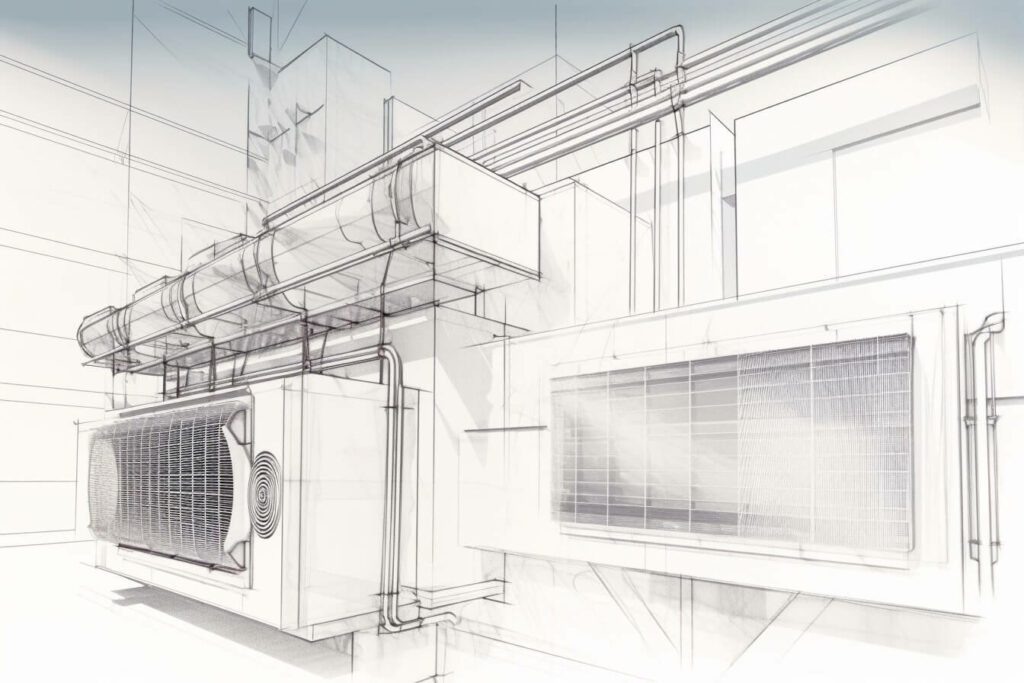




a FREE GLOBAL EVENT to the Forefront of SUSTAINABLE DESIGN
In recent years, indoor air quality (IAQ) has become a paramount concern for architects and interior designers.
With people spending more than 90% of their time indoors, it’s no surprise that the air we breathe inside our buildings can significantly impact our health, productivity, and well-being. ASHRAE 62.1, a standard developed by the American Society of Heating, Refrigerating, and Air-Conditioning Engineers, is at the forefront of addressing these concerns.
This comprehensive, SEO-friendly guide will answer the most asked questions about ASHRAE 62.1, delve into its importance, and explore how architects and interior designers can seamlessly integrate it into their projects.
What is ASHRAE 62.1?
ASHRAE 62.1, also known as “Ventilation for Acceptable Indoor Air Quality,” is a standard that establishes minimum ventilation rates and other requirements to promote acceptable IAQ in commercial, residential, and institutional buildings.
The standard’s primary goal is to regulate indoor air pollutants, minimize adverse health effects, and enhance occupants’ comfort and well-being. ASHRAE 62.1 provides guidelines for designers, engineers, and building owners to ensure adequate ventilation in indoor spaces while optimizing energy efficiency.
Why is ASHRAE 62.1 important for architects and interior designers?
- Health and well-being: IAQ directly impacts occupants’ health, comfort, and well-being. Poor IAQ can lead to sick building syndrome (SBS), where occupants experience acute health effects and discomfort without any identifiable cause. By adhering to ASHRAE 62.1, architects and interior designers can minimize the risk of SBS and create healthier spaces for occupants.
- Regulatory compliance: Many building codes, including the International Mechanical Code (IMC) and the International Building Code (IBC), reference ASHRAE 62.1 as a minimum ventilation requirement. Compliance with these codes is mandatory for obtaining building permits and certificates of occupancy.
- Energy efficiency: ASHRAE 62.1 addresses IAQ and emphasizes energy efficiency. By following the standard, designers can optimize ventilation systems to reduce energy consumption and lower operating costs for building owners.
- Sustainable design: Architects and interior designers prioritizing sustainability can utilize ASHRAE 62.1 to create environmentally responsible designs. Implementing the standard can contribute to green building certifications, such as LEED and WELL, showcasing a commitment to sustainability and occupant health.
How does ASHRAE 62.1 work?
ASHRAE 62.1 offers two primary ventilation rate procedures: the Ventilation Rate Procedure (VRP) and the Indoor Air Quality Procedure (IAQP).
- Ventilation Rate Procedure (VRP): The VRP prescribes minimum outdoor air ventilation rates based on space type, occupancy, and floor area. This approach aims to dilute indoor air pollutants by introducing a specific amount of fresh air per occupant and unit area. The VRP is the most common method designers use, as it is relatively straightforward.
- Indoor Air Quality Procedure (IAQP): The IAQP is a performance-based approach considering the concentration of specific indoor air contaminants. Designers must monitor and control pollutant concentrations to comply with established guidelines. While the IAQP allows for more flexibility and potential energy savings, it requires a more comprehensive understanding of the pollutants present in the space and the implementation of effective monitoring and control systems.


What are the key components of ASHRAE 62.1?
- Outdoor air intake: ASHRAE 62.1 emphasizes the importance of an adequately designed and located outdoor air intake. This component is essential for providing occupants with fresh air and diluting indoor air pollutants. The standard offers guidelines on intake location, separation distance from contaminant sources, and intake height above ground.
- Air filtration: To ensure optimal IAQ, the standard requires air filters with a Minimum Efficiency Reporting Value (MERV) rating of at least 8. However, a higher MERV rating may be necessary for specific applications or regions with high pollutant levels. Proper filter maintenance is also crucial for maintaining IAQ and ensuring system efficiency.
- Ventilation system design: ASHRAE 62.1 provides guidelines on designing ventilation systems that balance IAQ and energy efficiency. This includes considering system types, such as natural, mechanical, or hybrid, and implementing demand control ventilation (DCV) strategies to adjust outdoor air supply based on occupancy or air quality.
- Exhaust ventilation: The standard addresses the need for exhaust ventilation in spaces where indoor air pollutants are generated, such as kitchens, restrooms, and laboratories. Proper exhaust design helps maintain IAQ by removing contaminants at the source and preventing them from spreading throughout the building.
- System commissioning and maintenance: To ensure the long-term performance of ventilation systems, ASHRAE 62.1 emphasizes the importance of proper commissioning, maintenance, and monitoring. Periodic inspections and performance evaluations are vital for identifying and addressing potential issues, maintaining IAQ, and optimizing energy efficiency.
How can architects and interior designers incorporate ASHRAE 62.1 into their projects?
- Early collaboration: Engaging mechanical engineers and other specialists early in the design process is crucial for achieving compliance with ASHRAE 62.1. Collaborative efforts allow for a holistic approach to IAQ and help identify potential challenges and opportunities for optimization.
- Material selection: Architects and interior designers should choose low-emitting materials and finishes to minimize indoor air pollutant sources. By considering products with low VOC emissions, formaldehyde-free, and GREENGUARD certified, professionals, can reduce the potential for poor IAQ and contribute to a healthier indoor environment.
- Biophilic design: Incorporating biophilic design elements, such as natural ventilation, daylighting, and indoor plants, can not only enhance IAQ but also contribute to a more visually appealing and comfortable space. These elements can work with ASHRAE 62.1 requirements to create a holistic and sustainable design approach.
- Continuous education: Staying informed on the latest updates to ASHRAE 62.1 and related codes is essential for professionals to maintain compliance and create state-of-the-art designs prioritizing occupant health and well-being.








a FREE GLOBAL EVENT to the Forefront of SUSTAINABLE DESIGN
ASHRAE 62.1 and Post-Pandemic Design Considerations
The COVID-19 pandemic has profoundly impacted how we perceive and interact with our built environment. As architects and interior designers reassess their approach to designing healthy and resilient spaces, understanding the role of ASHRAE 62.1 in post-pandemic design considerations is crucial.
This section will explore integrating the standard into future-proof designs that prioritize occupant health, safety, and well-being.
Airborne Transmission and the Role of Ventilation
The pandemic highlighted the potential for airborne transmission of viruses in indoor spaces. Adequate ventilation, as outlined in ASHRAE 62.1, is critical in mitigating the spread of airborne pathogens by diluting and removing contaminated air. In the post-pandemic era, adhering to or exceeding the standard’s requirements will be essential to minimize the risk of disease transmission and protect occupants’ health.
Enhanced Filtration and Air Cleaning Strategies
In addition to ventilation, ASHRAE 62.1 emphasizes the importance of air filtration in maintaining IAQ. To address concerns about airborne pathogens, designers may consider implementing enhanced filtration systems with higher MERV ratings or integrating additional air cleanings technologies, such as ultraviolet germicidal irradiation (UVGI) or bipolar ionization.
These measures can complement ASHRAE 62.1 requirements and contribute to a more resilient indoor environment in the face of potential future pandemics or other health threats.
Flexibility and Adaptability in Design
The COVID-19 pandemic has underscored the need for flexibility and adaptability in our built environment. Architects and interior designers can integrate ASHRAE 62.1 into designs that allow for easy reconfiguration of spaces or adjustments to ventilation rates in response to changing occupancy patterns or health concerns. Strategies may include modular layouts, movable partitions, and demand-controlled ventilation systems that can be fine-tuned based on real-time IAQ data.
Emphasis on Outdoor Spaces and Natural Ventilation
The pandemic has reinforced the importance of outdoor spaces and natural ventilation in promoting occupant health and well-being. ASHRAE 62.1 can be combined with biophilic design principles to create spaces that maximize natural ventilation, daylighting, and outdoor connections.
Incorporating operable windows, skylights, and well-designed outdoor areas enhances IAQ and provides a more enjoyable and comfortable environment for building occupants.
Occupant Education and Awareness
In the post-pandemic world, occupant education and awareness about IAQ and its impact on health have become increasingly important. Architects and interior designers can work with building owners and facility managers to develop communication strategies and informational materials that highlight the ASHRAE 62.1-compliant features of their projects.
This can help occupants understand and appreciate proper ventilation and IAQ’s role in creating healthy, resilient spaces.
This can help occupants understand and appreciate proper ventilation and IAQ’s role in creating healthy, resilient spaces. Served as a wake-up call for designing healthy and resilient indoor spaces. By incorporating ASHRAE 62.1 into post-pandemic design considerations, architects and interior designers can create environments prioritizing occupant health, safety, and well-being.
Enhanced filtration, adaptable design, an emphasis on outdoor spaces and natural ventilation, and increased occupant education and awareness are essential components of this new approach.
As we continue to navigate the lasting effects of the pandemic, ASHRAE 62.1 will serve as a valuable resource for professionals looking to create spaces that not only meet today’s needs but are also prepared for potential future challenges.
ASHRAE 62.1: A Conclusion
ASHRAE 62.1 is an indispensable tool for architects and interior designers aiming to create healthy, comfortable, and sustainable indoor environments. By understanding and integrating the standard into their projects, professionals can achieve regulatory compliance and contribute to enhanced occupant well-being and energy efficiency.
To further support your journey toward sustainability, consider partnering with UGREEN sustainability consultancy services. Our team of experts can guide you in navigating ASHRAE 62.1 and implementing cutting-edge solutions for IAQ and energy optimization.
Additionally, check out UGREEN Skills, our sustainability educational platform for professionals and companies, to stay informed and up-to-date on the latest trends and best practices in sustainable design. Together, we can create a healthier, greener future.








a FREE GLOBAL EVENT to the Forefront of SUSTAINABLE DESIGN
If you need our services in the Portuguese language, click here.
